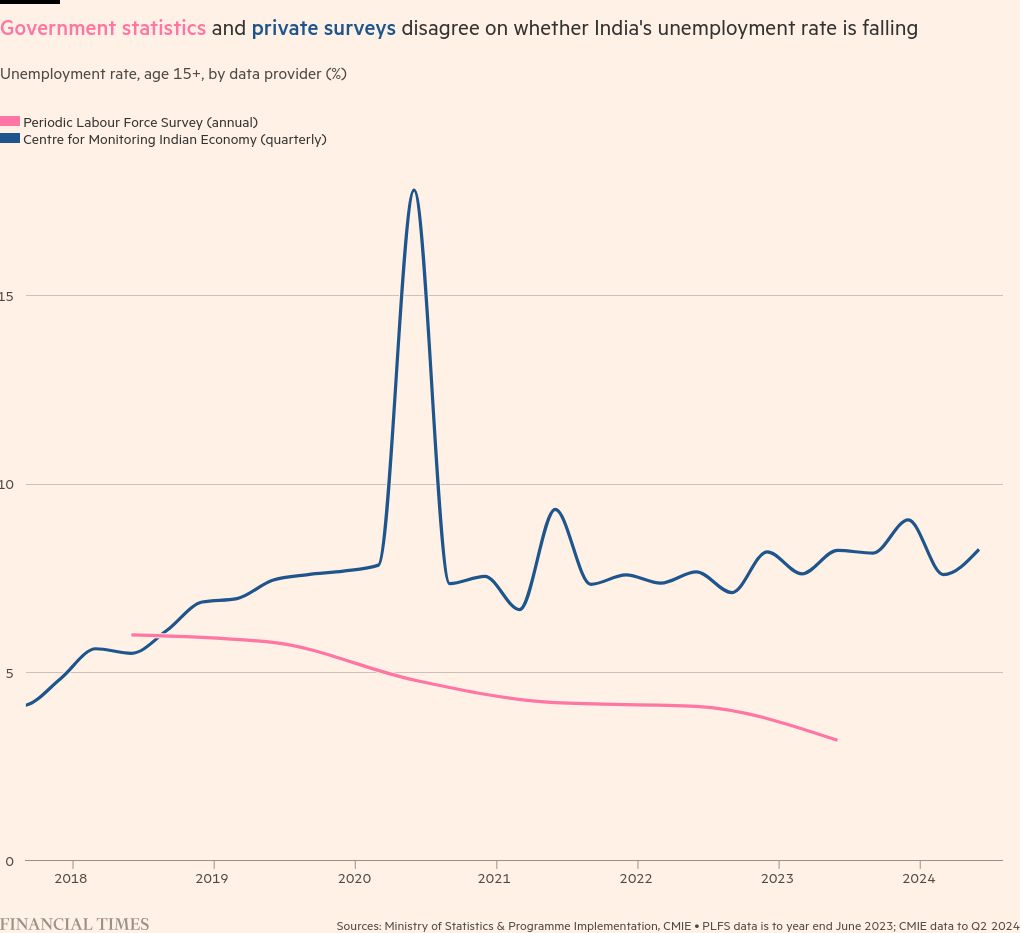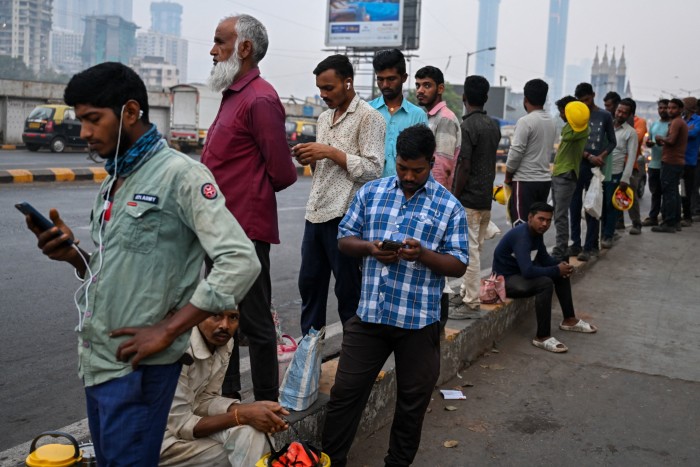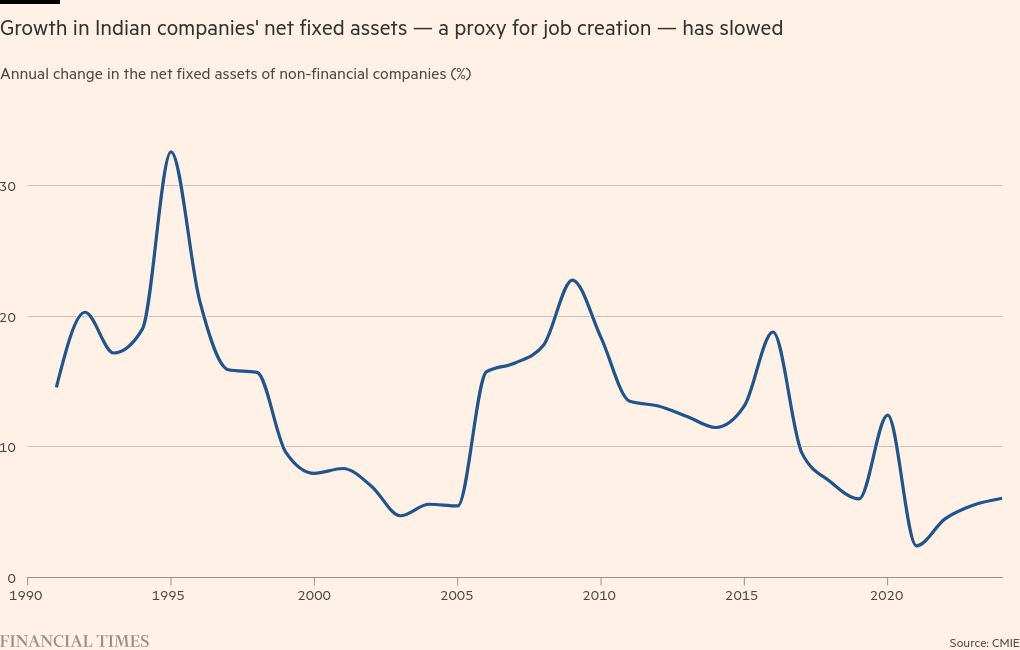
Ajesh Kumar, a college graduate in a village in Haryana, a rural state bordering Delhi, recently applied to work as a cleaner. But there were more than 400,000 jobseekers for an estimated 5,000 positions, making the 30-year old’s chances about one in 80.
“There’s just no hope, no chance” of getting one of the government posts, Kumar said, which are prized because of the guaranteed hours, wages and benefits, however low, of public sector work. Among the applicants were two of his family members.
Kumar is one face of India’s most intractable public policy issue: a chronic shortage of formal jobs in the world’s most populous country and, according to companies, a corresponding shortage of suitable candidates to fill them.
Prime Minister Narendra Modi’s economic record will again be on the agenda in Haryana on Saturday in one in a string of regional polls in which the opposition will seek to build momentum against his Bharatiya Janata party. The opposition managed to push the BJP into a parliamentary minority for the first time since 2014 in nationwide elections this year, in part by highlighting persistently high joblessness.
India’s economy is failing to create enough jobs for its young and growing population and train the skilled workers its companies need to harness that demographic dividend. This mismatch is feeding widespread grievances and represents one of the biggest challenges for Modi as he enters his second decade in power.
“Every month about a million formal job seekers are being added to the workforce,” says Rituparna Chakraborty, co-founder of Teamlease, which describes itself as India’s biggest staffing company. “Nine out of 10 of them go into the informal sector — jobs where there is no employment contract, no social security benefits, no protection, and no wage guarantees.”

“The poorest Indians tend to take on daily wage jobs in things like construction because there aren’t too many alternatives,” says Shruti Rajagopalan, senior research fellow at the Mercatus Center at George Mason University, in Virginia.
“The people in the middle are still waiting, and would rather hold out for a government job, or work on the family farm because at least it provides them food security.”
Modi’s government has taken steps to tackle India’s joblessness. In the first post-election budget, finance minister Nirmala Sitharaman announced an apprenticeship scheme aimed at benefiting 10mn young people over five years. The government has also promised training subsidies for companies, stipends for apprenticeships and help for vocational schools to amend their curricula to align with job market demands.
In its previous term, Modi’s cabinet also cut corporate taxes and took steps to amend labour laws in a bid to stimulate job growth.
Corporate India, however, laments a shortage of qualified candidates for its top jobs. Conglomerate Larsen & Toubro said in June that it faced a shortage of 45,000 skilled labourers and engineers across its businesses, which range from construction to information technology.
Analysts said the skills gap bodes ill for Modi’s “Make in India” manufacturing push, and attests to neglect and uneven standards at Indian secondary institutions.
“So many people come out of these colleges, but we can do a lot to make them more employable in the industry,” K Krithivasan, chief executive of Tata Consultancy Services, India’s biggest IT company, told the Financial Times earlier this year.

Mohandas Pai, chair of private equity firm Aarin Capital and former chief financial officer at IT giant Infosys, said most industries were struggling to find skilled workers as India’s economy expands at an annual clip of about 7 per cent, with job openings outpacing the supply of employable workers.
At the same time, he said: “Many industries are not willing to spend money to hire them, skill them and train them.”
A study published this year by Quess Corp, an Indian business service provider, and the Federation of Indian Chambers of Commerce and Industry argued that India faced a wage — rather than an employment — problem. About 80 per cent of jobs pay less than Rs20,000 ($238) a month, not enough to meet rising living expenses, the study’s authors argued.
On the supply side, economists say cumbersome labour regulation is also holding back industry from creating jobs. Much of the legislation only kicks in for companies employing 10 people or more, points out George Mason University’s Rajagopalan. “Either people are not hiring the 10th worker, or they hire the worker informally,” she said.
Modi’s government in 2020 approved an overhaul of India’s patchwork of labour laws, which regulate areas ranging from maximum shift hours to the number of clocks per factory floor. But the reforms have yet to take effect.

There is even disagreement over how to measure India’s unemployment. The Centre for Monitoring Indian Economy, a think-tank, publishes the most widely cited indicator, which is conducted monthly. In August, it showed a jobless rate at 8.51 per cent, and unemployment on a rising trend.
“This is a pretty high unemployment rate in a country growing at 7 to 8 per cent per annum,” says Mahesh Vyas, CMIE’s managing director. “We have also been seeing the unemployment rate very high for a long period now in both rural and urban regions.”
Modi’s political circle favours the Periodic Labour Force Survey, which reports quarterly rural and urban unemployment rates and shows the jobless rate at below 5 per cent and falling.
Analysts said the discrepancy was because of what counted as work, including part-time agricultural work.
Vyas claims the definition of a job in the PLFS is “too relaxed”. He also pointed to growth of India’s net fixed assets at companies, which he said served as a proxy for employment and joblessness and has been growing at only about 5-6 per cent in recent years.
“Employment will increase only if investments increase, and I don’t see that,” Vyas said.
Kumar, in Haryana, for example, might or might not qualify as unemployed depending on who is counting. He is earning some money on commission for a company that sells cattle feed, and is considering setting up a dairy business with his brother.
Like many young Indians, he also aspired to an army post, completing a correspondence degree in political science and passing the written test three times. But he was rejected in the interview.
“You need sources and contacts when you reach that level,” Kumar said. “I did not have them.”
“I have given up looking for jobs,” he added.